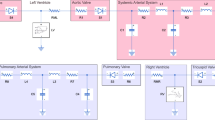Abstract
Aim of this work was to develop a modular computational model able to interact with ventricular assist devices (VAD) for research and educational applications. The lumped parameter model consists of five functional modules (left and right ventricles, systemic, pulmonary, and coronary circulation) that are easily replaceable if necessary. The possibility of interacting with VADs is achieved via interfaces acting as impedance transformers. This last feature was tested using an electrical VAD model. Tests were aimed at demonstrating the possibilities and verifying the behavior of interfaces when testing VADs connected in different ways to the circulatory system. For these reasons, experiments were performed in a purely numerical mode, simulating a caval occlusion, and with the model interfaced to an external left-VAD (LVAD) in two different ways: with atrioaortic and ventriculoaortic connection. The caval occlusion caused the leftward shift of the LV p–v loop, along with the drop in arterial and ventricular pressures. A narrower LV p–v loop and cardiac output and aortic pressure rise were the main effects of atrioaortic assistance. A wider LV p–v loop and a ventricular average volume drop were the main effects of ventricular-aortic assistance. Results coincided with clinical and experimental data attainable in the literature. The model will be a component of a hydronumerical model designed to be connected to different types of VADs. It will be completed with autonomic features, including the baroreflex and a more detailed coronary circulation model.









Similar content being viewed by others
References
Zhou J, Armstrong GP, Medvedev AL, Smith WA, Golding LA, Thomas JD. Numeric modeling of the cardiovascular system with a left ventricular assist device. ASAIO J. 1999;45:83–9.
Shi Y, Korakianitis T, Bowles C. Numerical simulation of cardiovascular dynamics with different types of VAD assistance. J Biomech. 2007;40:2919–33.
Ferrari G, Kozarski M, De Lazzari C, Clemente F, Merolli M, Tosti G, Guaragno M, Mimmo R, Ambrosi D, Głapinski J. A hybrid (numerical-physical) model of the left ventricle. Int J Artif Organs. 2001;24:456–62.
Baloa LA, Boston JR, Antaki JF. Elastance-based control of a mock circulatory system. Ann Biomed Eng. 2001;29:244–51.
Colacino FM, Arabia M, Danieli GA, Moscato F, Nicosia S, Piedimonte F, Valigi P, Pagnottelli S. Hybrid test bench for evaluation of any device related to mechanical cardiac assistance. Int J Artif Org. 2005;28:817–26.
Gwak K-W, Paden BE, Noh MD, Antaki JF. Fluidic operational amplifier for mock circulatory systems. IEEE Trans Con Syst Tech. 2006;14:602–12.
Ferrari G, De Lazzari C, Kozarski M, Clemente F, Górczyńska K, Mimmo R, Monnanni E, Tosti G, Guaragno M. A hybrid mock circulatory system: testing a prototype under physiologic and pathological conditions. ASAIO J. 2002;48:487–94.
Colacino FM, Moscato F, Piedimonte F, Danieli G, Nicosia S, Arabia M. A modified elastance model to control mock ventricles in real-time: numerical and experimental validation. ASAIO J. 2008;54:563–73.
Ferrari G, Kozarski M, De Lazzari C, Górczyńska K, Tosti G, Darowski M. Development of a hybrid (numerical-hydraulic) circulatory model: prototype testing and its response to IABP assistance. Int J Artif Organs. 2005;28:750–9.
Ferrari G, Kozarski M, Gu YJ, De Lazzari C, Di Molfetta A, Pałko KJ, Zieliński K, Górczyńska K, Darowski M, Rakhorst G. Application of a user friendly comprehensive circulatory model for hemodynamic and ventricular variables estimate. Int J Artif Organs. 2008;31:1043–54.
Sagawa K, Maughan L, Suga H, Sunagawa K. Cardiac contraction and the pressure–volume relationship. New York: Oxford University Press; 1988.
Campbell KB, Kirkpatrick RD, Knowlen GG, Ringo JA. Late-systolic pumping properties of the left ventricle. Deviation from elastance-resistance behaviour. Circ Res. 1990;66:218–33.
Gilbert JC, Glantz SA. Determinants of left ventricular filling and of the diastolic pressure-volume relation. Circ Res. 1989;64:827–52.
Korakianitis T, Shi Y. A concentrated parameter model for the human cardiovascular system including heart valve dynamics and atrioventricular interaction. Med Eng Phys. 2006;28:613–28.
Di Molfetta A, Cesario M, Tota C, Santini L, Forleo GB, Sgueglia M, Ferrari G, Romeo F. Use of a comprehensive numerical model to improve biventricular pacemaker temporization in patients affected by heart failure undergoing to CRT-D therapy. Med Biol Eng Comput. 2010;48:755–64.
Heldt T, Shim EB, Kamm RD. Mark RG Computational modeling of cardiovascular response to orthostatic stress. J Appl Physiol. 2002;92:1239–54.
Avolio AP. Multi-branched model of the human arterial system. Med Biol Eng Comput. 1980;18:709–18.
Downey JM, Kirk ES. Inhibition of coronary blood flow by a vascular waterfall mechanism. Circ Res. 1975;36:753–60.
Darowski M, De Lazzari C, Ferrari G, Clemente F, Guaragno M. Computer simulation of hemodynamic parameter changes by mechanical ventilation and biventricular circulatory support. Methods Inf Med. 2000;39:332–8.
Ferrari G, Kozarski M, De Lazzari C, Górczyńska K, Mimmo R, Guaragno M, Tosti G, Darowski M. Modelling of cardiovascular system: development of a hybrid (numerical-physical) model. Int J Artif Organs. 2003;26:1104–14.
Kozarski M, Ferrari G, Zieliński K, Górczyńska K, Pałko KJ, Tokarz A, Darowski M. A new hybrid electro-numerical model of the left ventricle. Comput Biol Med. 2008;38:979–89.
Haft J, Armstrong W, Dyke DB, Aaronson KD, Koelling TM, Farrar DJ, Pagani FD. Hemodynamic and exercise performance with pulsatile and continuous-flow left ventricular assist devices. Circulation. 2007;116(Suppl):I8–15.
Baan J, van der Velde ET, de Bruin HG, Smeenk GJ, Koops J, van Dijk AD, Temmerman D, Senden J, Buis B. Continuous measurement of left ventricular volume in animals and humans by conductance catheter. Circulation. 1984;70:812–23.
Ferrari G, Kozarski M, De Lazzari C, Górczyńska K, Pałko KJ, Zieliński K, Di Molfetta A, Darowski M. Role and applications of circulatory models in cardiovascular pathophysiology. Biocybern Biomed Eng. 2009;29:3–24.
SensorART—A remote controlled Sensorized ARTificial heart enabling patients empowerment and new therapy approaches—Integrated Project funded within the framework of the European Community’s Seventh Framework Programme (FP7/2007-2013) under grant agreement no. 248763. (http://www.sensorart.eu).
Author information
Authors and Affiliations
Corresponding authors
Appendix
Rights and permissions
About this article
Cite this article
Ferrari, G., Kozarski, M., Zieliński, K. et al. A modular computational circulatory model applicable to VAD testing and training. J Artif Organs 15, 32–43 (2012). https://doi.org/10.1007/s10047-011-0606-4
Received:
Accepted:
Published:
Issue Date:
DOI: https://doi.org/10.1007/s10047-011-0606-4




